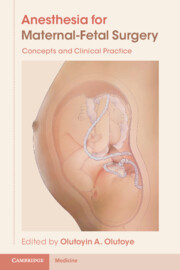Book contents
- Anesthesia for Maternal-Fetal Surgery
- Anesthesia for Maternal-Fetal Surgery
- Copyright page
- Dedication
- Contents
- Contributors
- Abbreviations
- Preface
- Acknowledgments
- Section 1
- Section 2
- Chapter 6 Twin-Twin Transfusion Syndrome
- Chapter 7 Fetal Endoscopic Tracheal Occlusion (FETO)
- Chapter 8 Fetal Cardiac Intervention
- Chapter 9 Antepartum Fetal Monitoring
- Section 3
- Index
- Endmatter
- References
Chapter 9 - Antepartum Fetal Monitoring
from Section 2
Published online by Cambridge University Press: 19 November 2021
- Anesthesia for Maternal-Fetal Surgery
- Anesthesia for Maternal-Fetal Surgery
- Copyright page
- Dedication
- Contents
- Contributors
- Abbreviations
- Preface
- Acknowledgments
- Section 1
- Section 2
- Chapter 6 Twin-Twin Transfusion Syndrome
- Chapter 7 Fetal Endoscopic Tracheal Occlusion (FETO)
- Chapter 8 Fetal Cardiac Intervention
- Chapter 9 Antepartum Fetal Monitoring
- Section 3
- Index
- Endmatter
- References
Summary
Prenatal fetal monitoring allows for the detection of abnormal physiologic conditions in the fetus. The different available methods can detect abnormalities in utero-placental perfusion, as well as physiologic changes during and after in-utero fetal surgery. Basic antepartum fetal monitoring in viable fetuses has advanced over the years and now involves not only the nonstress test but more advanced methods which also take into account the ultrasound findings. Comprehension of the different fetal heart rate tracings allow for rapid intervention where necessary. Unfortunately, while many modes of surveillance exist, no single method can accurately identify a fetus that will progress to being stillbirth.
Keywords
- Type
- Chapter
- Information
- Anesthesia for Maternal-Fetal SurgeryConcepts and Clinical Practice, pp. 119 - 136Publisher: Cambridge University PressPrint publication year: 2021

